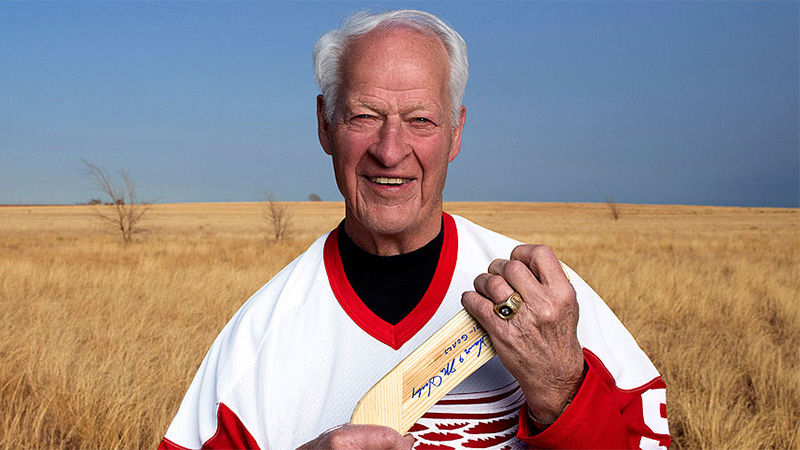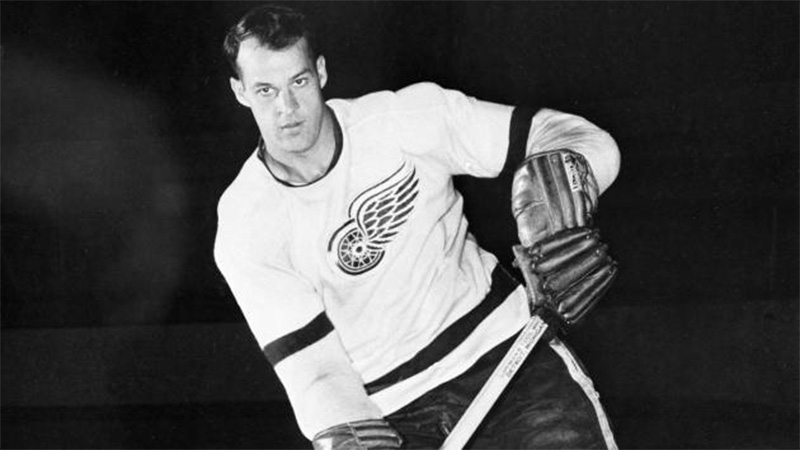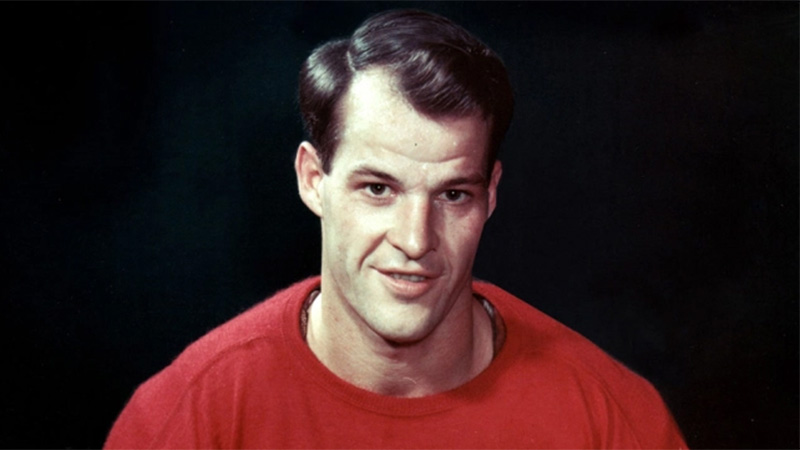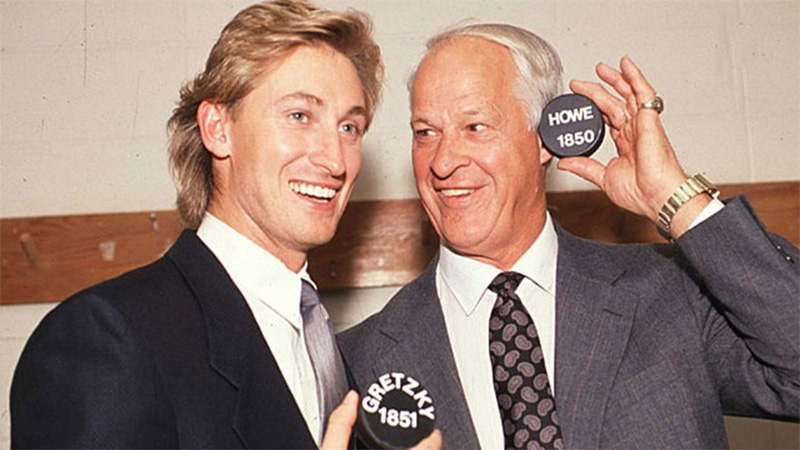Having watched hockey since 1939, and having seen Gordie Howe from his rookie season, 1946-47 on, I can say without question that he was the best player that I’ve ever seen, goaltenders excluded.
Better than Maurice (Rocket) Richard, legitimately considered to be “The Babe Ruth Of Hockey.”
Better than Wayne Gretzky, who required “policemen” to fight his battles for him.
Better than Mario Lemieux, who lacked the grit and gumption of Gordie.
Better than any of today’s glitterati on ice.
Howe, who died on Friday at the age of 88, could do everything on the ice in what he called “A man’s game.”

He was the best fighter in the league: never lost a bout, but fought two draws with Rangers defensemen Fred Shero and Jack Evans on separate occasions.
He was the only ambidextrous superstar, who could fire the puck equally as well from the left or right side.
He was so adroit at stick-handling, that opponents liked to say, “Gordie plays the “funny” kind of game — he doesn’t let anyone else touch the puck.”
It was a measure of Howe’s dominance that when he finally retired from the NHL — for the first time — prior to the 1971-72 season, he’d played in 1,687 games, scored 786 goals, 1,023 assists, 1,809 points, and received 1,643 penalty minutes — each item a league record.
From 1946-1957, Howe won the Hart and Art Ross Trophies six times. His artistry, versatility, durability, and the fact that he successfully spanned three distinct hockey eras, marked him as unique in sports, and at the apex of hockey achievements.
“He wasn’t only the greatest hockey player I’ve ever seen,” said former teammate and Hall of Famer Bill Gadsby, “but also the greatest athlete.”
Howe was born on the outskirts of Saskatoon in Canada’s wheat belt. He was the fourth of the nine children of Catherine and Albert Howe. After an unsuccessful try at farming, Albert moved the family to town, where he got a job in a garage. It was in Saskatoon that Gordie learned to play hockey. In the winter, temperatures in Saskatoon drop to 50 below zero. Ten below was balmy.
“As a kid,” Gordie remembered, “the only equipment I had was skates and a stick. I took magazines and mail-order catalogs, stuck them in my socks, and made myself shin pads. I tied them together with rubber bands made from inner tubes. We played with tennis balls instead of a puck. The ball would get so hard from the cold that we’d have to get new ones all the time. A woman next door used to warm them up in an oven for us.”
Gordie quit school and got a job with a construction company that was building sidewalks. It was tough work lugging 85-pound cement bags, but it firmed up his muscles. Construction work though, was just a fill-in between hockey seasons.
“I guess he always knew he’d become a hockey player,” Howe’s mother once said. “He used to practice at night by the hour under the city lamp on the streets. I put papers on the kitchen floor so he wouldn’t have to take his skates off while he ate.”
Gordie carried his diffidence right into the dressing room when he attended a Rangers training camp in Winnipeg as a 15-year old. He was especially embarrassed because he had no idea how to adjust the complicated equipment that the pros wore.
“I just dropped the gear on the floor in front of me and watched the others,” he said. “I found out pretty early that the best way to learn was to keep my mouth shut and my eyes open.”
He was a homesick teenager. When his roommate left for home, Gordie sulked for two days, and then he too departed. The next year, he was invited to the Detroit camp at Windsor, Ontario. He was signed to a contract by Jack Adams, and was assigned to the Red Wings’ junior farm team in Galt, Ontario. Because of a Canadian Amateur Hockey Association ruling, he was unable to play for a year. Instead, he worked out with the team and played in exhibitions.

The Red Wings wanted him to enroll in Galt’s high school. When Gordie saw all the kids clustered in front of the building, he turned around, walked down a railroad track, and applied for a job with Galt Metal Industries as a spot welder.
The next year, he played with Omaha, and in 1946, he joined the Red Wings. In his first three years, he scored 7, 16, and 12 goals. His genius finally surfaced during the 1949 playoffs, when he was the high scorer with 8 goals and 11 points.
“I still wasn’t so sure that I was a star,” he said. “When I went home to Saskatoon that summer, I started playing baseball again. One day, a kid came up to me and asked for an autograph, and while I signed it, he said ‘Mr. Howe, what do you do in the winter?'”
The goals began to come in bunches, and Howe mesmerized both enemy and teammate alike. His stick-handling was so uncanny, captain Sid Abel felt moved to reprimand young Gordie. “I don’t mind this great stick-handling of yours,” said Abel, “but why stick-handle around the same player three times?”
Howe was the perfect athlete. Taken to a golf course, he outdrove Chick Harbert, then PGA champion. When Gordie told former Cleveland Indians manager Lou Boudreau that he could hit big-league pitching, Boudreau invited him out to the park. The Indians manager fetched one of his best pitchers, and told him to throw good and hard at Howe. Gordie proceeded to line the third pitch into the left field bleachers.
As a hockey player, Howe reached his peak from this stretch: in 1950-51, when he led the NHL in scoring with 86 points (43 goals, 43 assists); in 1951-52 with 86 points (47 goals, 39 assists); in 1952-53 with a then record 95 points (49 goals, 46 assists); and in 1953-54 with 81 points (33 goals, 48 assists).

No other player had ever led the league more than two years in a row up to that point. Gordie again was at the top of the scoring list in 1956-57 (44 goals, 45 assists), and continued to dominate the game throughout the late ’50s and early ’60s.
Howe remained a major factor in the NHL until his retirement. Then, to everyone’s amazement, he surfaced again, this time in 1973 in the World Hockey Association.
Miracles occur in big-league hockey about once every half-century. In 1973-74, there were several: Gordie Howe returned to the ice at age 45, and sons Marty and Mark signed to skate alongside Pop with the Houston Aeros. Then the three Howes led Houston to the AVCO World Cup, and the WHA title.
Gordie next starred for Team Canada in 1974 against the young Russians, before orchestrating a second AVCO Cup win in 1975. The Gordie of 1973-75 wasn’t the Howe who won six Hart Trophies, mind you. He was a stride slower, but a stride wiser.
His shot had less oomph, and injuries inspired him to put a bit of a curve in his formerly flat stick. However, when he skated at a foe, he was the same man who once pulverized the NHL’s “heavyweight champion,” the Rangers’ Lou Fontinato, and anyone else who dared to challenge him.
Gordie made his debut with his kids on September 25, 1973, playing in a WHA spectacular at Madison Square Garden. Less than a minute after he stepped on the ice, he scored a goal. He received a standing ovation, but the decibel count didn’t fool Gordie.
His muscles were rusty, and his timing was off. Once during a practice, he crashed headfirst into the boards, and looked like a corpse. However, he rebounded, and with each week, he gained more speed and more points. When the season ended, the Aeros were champs of the WHA’s Western Division, and Gordie had scored 31 goals and 69 assists for 100 points, third best in the WHA.
When Houston bowed out of the WHA, Gordie and family moved north to the New England Whalers for 1977-78 campaign. The Whalers were admitted to the NHL in 1979, and with Gordie really beginning to show the strain, he called it quits (a second time) in 1980.
His NHL totals were an astounding 801 goals, 1,049 assists and 1,850 points over 26 seasons as an NHL gladiator, which stood long and proud, until they were all broken by Wayne Gretzky in the 1990s.

Howe’s legacy remained visible to many new hockey audiences, partly thanks to Gretzky’s accomplishments, and “Mr. Hockey” still remained the NHL’s all-time leader in games played with 1,767 entering the millennium — not even counting the WHA years.
A brief stint in which he played one shift for the IHL’s Detroit Vipers in 1997-98, in order to set a record for most decades of playing professional hockey (six) may have been a farce, but it still reminded the hockey world of Howe’s unparalleled athleticism and longevity.
What made Gordie so special, apart from his natural gifts as a player, was his down-to-earth nature. He was a regular guy to everyone, and remained one of the most popular performers all-time, purely on a social basis.
How shall we remember this wonderful man?
As author of Howe’s biography, I like to think about his droll sense of humor. Then I recall how he demolished the toughest big-leaguers such as New York’s Nick Fotiu, not to mention any other brute who came down the pike.
He was a devoted father and husband, and just about the best advertisement that major league hockey ever had.
As the late, great W.C. Fields would have put it, “What a man; what a guy!”